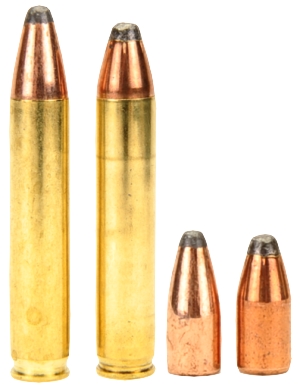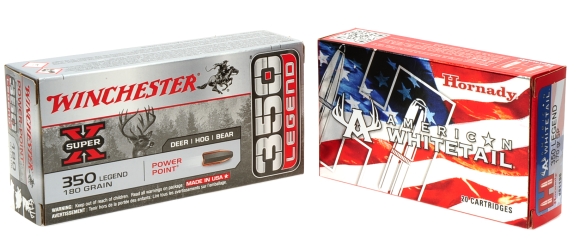 In early exposure to the 350 Legend, Ruger’s Compact American Rifle Ranch and the 350 Legend Part I and Ruger’s Compact American Rifle Ranch and the 350 Legend Part II, the 350 Legend proved to be not only an excellent cartridge for the deer hunter in states where only straight wall cartridges are mandated, but also in any hunting environment where shots are inside 200 yards. By dimension and operating pressure, the 350 Legend cartridge is well suited to bolt action, lever action and auto-loading firearms..
In early exposure to the 350 Legend, Ruger’s Compact American Rifle Ranch and the 350 Legend Part I and Ruger’s Compact American Rifle Ranch and the 350 Legend Part II, the 350 Legend proved to be not only an excellent cartridge for the deer hunter in states where only straight wall cartridges are mandated, but also in any hunting environment where shots are inside 200 yards. By dimension and operating pressure, the 350 Legend cartridge is well suited to bolt action, lever action and auto-loading firearms..
Glad to see the arrival of more factory ammunition for the 350 Legend. The presence of more manufacturers will push performance and evolution of the cartridge, give the new round greater traction in the market place and brand competition will make for reasonable prices. The Hornady 350 Legend 170 Grain Interlock® American Whitetail® ammunition underscores those points.
Comparing the Hornady 350 Legend 170 Grain Interlock® American Whitetail® with Winchester’s Power-Point 180 grain ammunition because of their similarities in application and bullet weights should be straight forward. Unfortunately, each manufacturer has their own perspective on conventions used for ballistic tables and each presents specification information differently.
Winchester applies a 100 yard zero to exterior ballistics and Hornady applies a 200 yard zero. Winchester publishes a ballistic coefficient for its Power-Point bullet, 0.221, Hornady did not post a BC for its Interlock bullet. Both Winchester and Hornady published data are based on a 20″ barrel while, as of 04/09/2019, the SAAMI standard test barrel length is 16″.
The Ranch version of the Ruger American Rifle used has a 16.38″ barrel. Rather than set an arbitrary fixed zero distance, we used a best zero for a 6″ target . The ballistic coefficient for the Hornady bullet, 0.2136, was derived by hitting reverse on the exterior ballistic calculator until the curves matched.
Live fire
Over the chronograph, the Winchester ammunition rated at 2100 fps, clocked 2091 fps, Hornady ammunition rated at 2200 fps, clocked 2190 fps. The difference between rated and actual velocity was essentially the same for both types. Considering a 20″ barrel is the ammunition manufacturers’ standard, that is very good performance from a firearm with a nearly 4″ shorter barrel.
The Hornady cartridge puts 100 fps on the Winchester round 2190 fps versus 2091, so even though the Hornady has a lighter 170 grain bullet, it cranks out 1811 ft-lbs of kinetic energy at the muzzle, compared to 1651 ft-lbs for the Winchester round; energy increases as the square of the velocity.
How does that look with some of the other exterior ballistic elements?
The Winchester assumptions are based on recorded muzzle velocity, a 165 yard best zero, a 176 yard point blank range and a maximum ordinate of +3″. The Hornady assumptions are based on recorded muzzle velocity, a 172 yard best zero, 182 yard point blank range and a maximum ordinate of +3″.
| Winchester 180 Grain Power-Point & Hornady 170 Grain American Whitetail | ||||||||
| Yards | 0 | 50 | 100 | 150 | 200 | 250 | 300 | |
| Winchester Velocity – fps | 2091 | 1919 | 1756 | 1602 | 1463 | 1337 | 1229 | |
| Hornady Velocity – fps |
2190 | 2007 | 1833 | 1669 | 1519 | 1383 | 1264 | |
| Winchester Energy – ft.-lbs | 1747 | 1471 | 1232 | 1026 | 855 | 714 | 604 | |
| Hornady Energy ft-lbs |
1810 | 1520 | 1269 | 1052 | 871 | 722 | 603 | |
| Winchester Momentum – lbs-sec | 54 | 49 | 45 | 41 | 38 | 34 | 32 | |
| Hornady Momentum – lbs-sec | 53 | 49 | 45 | 41 | 37 | 34 | 31 | |
| Winchester Path – inches | -1.50 | 1.92 | 2.97 | 1.20 | -3.97 | -13.21 | -27.31 | |
| Hornady Path – inches | -1.50 | 1.83 | 2.99 | 1.56 | -3.00 | -11.33 | -24.22 | |
| Winchester Time Of Flight – sec. | 0.00 | 0.07 | 0.16 | 0.25 | 0.34 | 0.45 | 0.57 | |
| Hornady Time of Flight – sec | 0.00 | 0.07 | 0.15 | 0.24 | 0.33 | 0.43 | 0.55 | |
The Winchester Power-Point and Hornady Whitetail ammunition offer similar performance, with Hornady holding a a slight edge. Repeatable accuracy yielded similar results.

 The combination of short barrel Ruger American Rifle Ranch and 350 Legend cartridge has proven to be inherently accurate. Working with handloads, drawing down bullets and picking through a variety of powders, handloads produced group 100 yard sizes down to half inch. Winchester 145 grain FMJ factory ammo shot a best of 1 1/4″ in one of our first projects with this combination, the 180 grain Winchester Power-Point consistently shot 1.0″ groups, warm or cold barrel. The Hornady Whitetail ammo consistently shot 0.8″ groups, also warm or cold barrel. Makes it difficult to justify handloads for medium to large game hunting unless, you’re loading a particular bullet type that is not available with over the counter ammunition.
The combination of short barrel Ruger American Rifle Ranch and 350 Legend cartridge has proven to be inherently accurate. Working with handloads, drawing down bullets and picking through a variety of powders, handloads produced group 100 yard sizes down to half inch. Winchester 145 grain FMJ factory ammo shot a best of 1 1/4″ in one of our first projects with this combination, the 180 grain Winchester Power-Point consistently shot 1.0″ groups, warm or cold barrel. The Hornady Whitetail ammo consistently shot 0.8″ groups, also warm or cold barrel. Makes it difficult to justify handloads for medium to large game hunting unless, you’re loading a particular bullet type that is not available with over the counter ammunition.
I can’t say exactly why the Hornady ammo delivered greater accuracy, but I would attribute it to the difference in bullet form and the effect that has on pressure, barrel vibration and perhaps bullet center of pressure.
The Winchester appearance is a bit deceptive. The heel of the bullet is 0.355″ but tapers to 0.353″ just aft of the ogive. Might be to create a home for a taper crimp, but it would also decrease bore friction. The Hornady has a short shank and long ogive, which serves to reduce bore friction to a greater extent.
| Cartridge | OAL | Bullet Grains |
Bullet OAL” |
Shank Length” |
Ogive Length” |
Case Net Capacity |
| Winchester | 2.165 | 180 | 0.855 | 0.440 | 0.415 | 25.7 |
| Hornady | 2.250 | 170 | 0.880 | 0.360 | 0.520 | 27.2 |
A lot of work to get to a 30-30 WCF…
Yeah, I know. There is always one in the bunch. Still the case as where we came in, the cartridge was released to accommodate hunters in states where they are restricted to use straight body cartridges and the 30-30 WCF is a bottle neck cartridge. Additionally, the 350 Legend utilizes bullets of a significantly larger diameter, it is more accurate than the 30-30 WCF cartridge, and its length fits the dimensional constraints of modern sporting rifles… AKA AR-15.


Email Notification